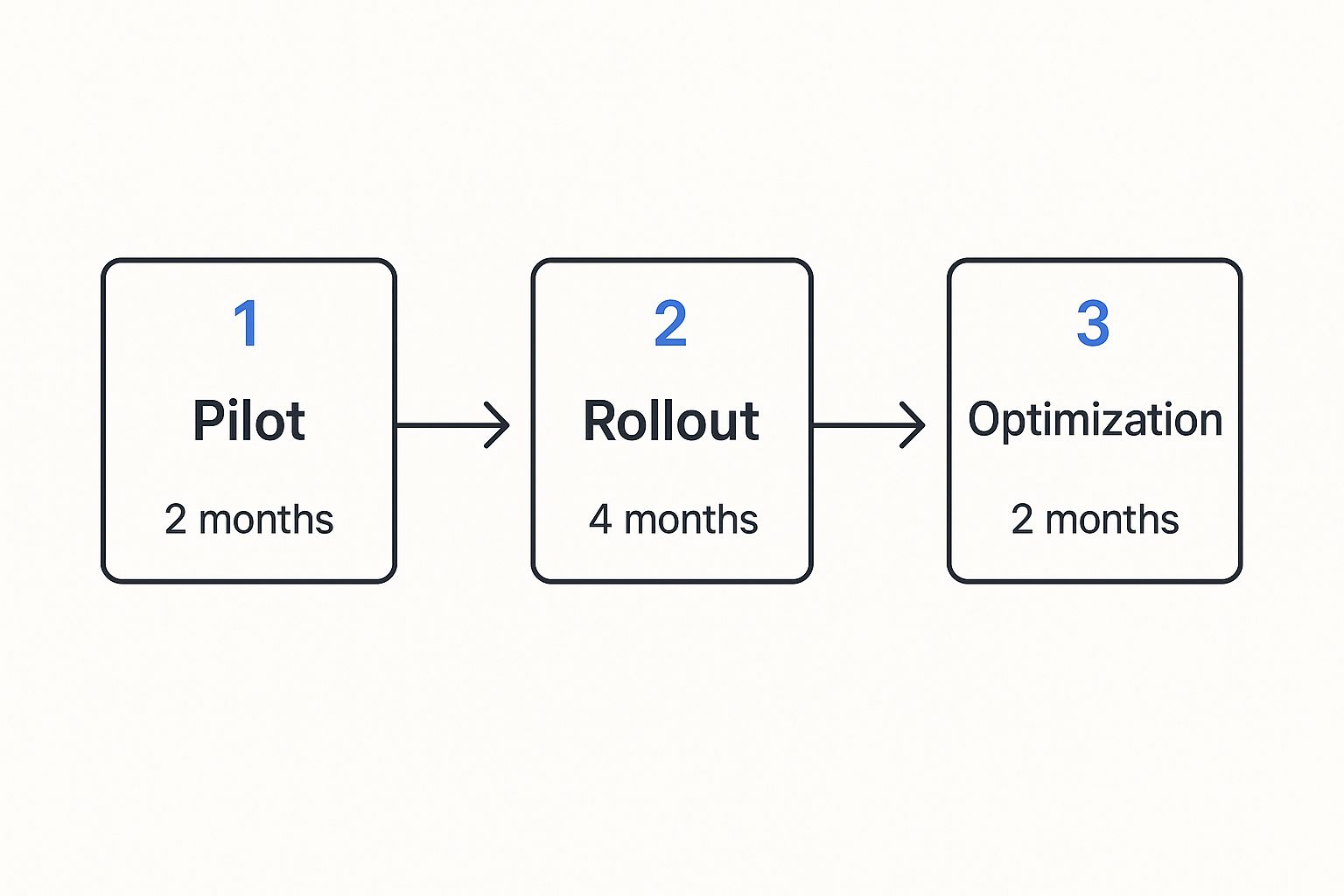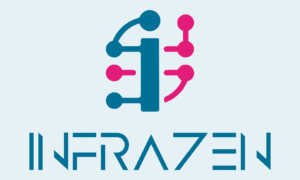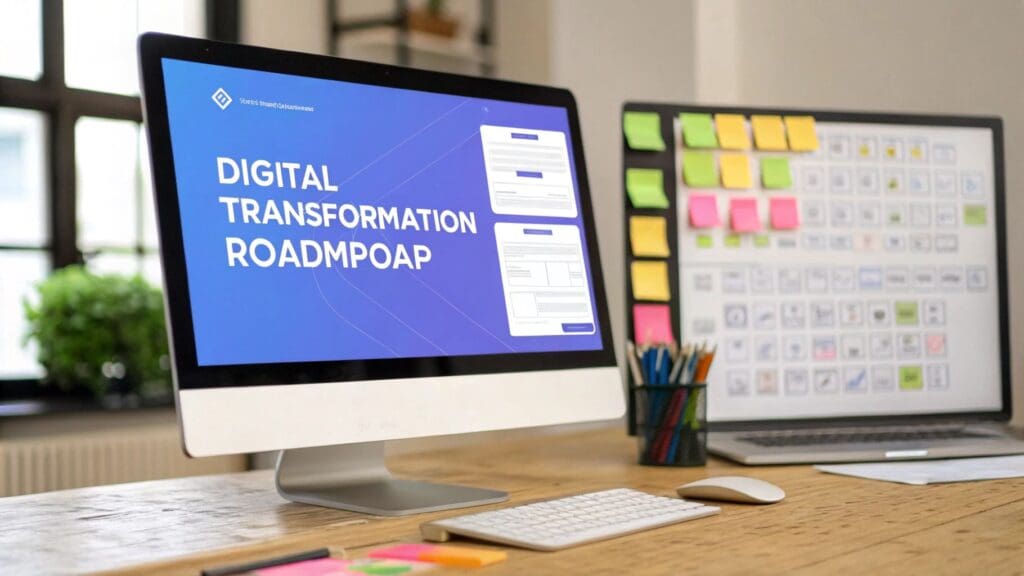Let's be honest, "digital transformation" gets thrown around so much it’s almost lost all meaning. But for a creative agency in the UK, it’s not just another buzzword—it’s a critical plan for survival and growth. This isn't about buying every flashy new piece of software that comes along. It's about a fundamental, deliberate shift in how your agency operates, collaborates, and delivers real value to clients.
A digital transformation roadmap is the strategic plan that guides this entire process. It’s what stops you from making expensive, disconnected tech investments that don't solve your core business problems. Without one, you're just guessing.
Why Your Agency Needs a Digital Transformation Roadmap

Think of it this way: a roadmap forces you to look under the bonnet and analyse the real mechanics of your agency. Instead of just reacting to problems as they pop up—like a clunky approvals process or a chaotic server—you start building proactive, strategic solutions for growth.
It’s about moving from a state of constant fire-fighting to one of intentional, controlled evolution.
The Real-World Benefits for Your Agency
When you start thinking strategically about your digital setup, you unlock tangible benefits that directly impact your bottom line and, most importantly, your creative output. The whole point is to build a more resilient, efficient, and innovative agency.
Here’s what that actually looks like:
- Enhanced Operational Efficiency: Imagine automating all those repetitive admin tasks that bog down your team. Things like client onboarding or timesheet chasing. This frees up your best people to focus on what they were hired for: producing amazing creative work.
- Improved Client Collaboration: Modern tools can create a single, transparent channel for clients. No more digging through endless email chains for the latest feedback or wrestling with version control. A centralised portal for proofs and approvals makes life easier for everyone.
- New Creative Capabilities: Embracing the right technology can open up entirely new services. You could start offering data-driven design, interactive content, or even use AI to spark new ideas, giving you a serious advantage over the competition.
- Better Data-Driven Decisions: A solid digital foundation lets you track what’s actually working. You can finally get clear data on project profitability, team capacity, and client satisfaction, which helps you make much smarter business decisions.
The market in the UK is already showing how urgent this is. The national digital transformation market was valued at $35.11 billion in 2022 and is expected to rocket up at 27.7% annually until 2030. That growth, massively accelerated by the pandemic, proves that digital maturity is no longer a "nice-to-have". If you're interested, you can explore more about these market trends and their implications for UK businesses.
A roadmap isn't just a technical document; it's a business strategy. It aligns your technology investments with your long-term agency goals, ensuring every pound spent on tech pushes the business forward.
To put it simply, a digital transformation roadmap is your agency's blueprint for the future. It turns a massive, intimidating concept into a series of clear, manageable steps that ensure you evolve with purpose. This guide will walk you through creating that very blueprint.
To get started, it helps to understand the fundamental building blocks of a solid roadmap. We've summarised them in the table below. Think of these as the core pillars that will support your entire transformation effort.
Core Pillars of a Digital Transformation Roadmap
| Pillar | Objective | Key Activities |
|---|---|---|
| Current State Assessment | To get an honest picture of where you are right now. | Auditing current tools, workflows, team skills, and client feedback. Identifying pain points and inefficiencies. |
| Vision & Objectives | To define what success looks like for your agency. | Setting clear, measurable goals (e.g., increase efficiency by 20%, launch a new digital service). |
| Strategic Milestones | To break the journey into manageable phases. | Mapping out key projects and initiatives on a timeline with clear owners and deliverables. |
| Technology Selection | To choose the right tools for the job, not just the trendiest ones. | Researching, vetting, and selecting software and platforms that align with your specific objectives. |
| Success Measurement | To track progress and ensure you're getting a return on your investment. | Defining KPIs, setting up dashboards, and establishing a process for regular review and adjustment. |
With these pillars in mind, you have a structured framework to begin planning. Each one builds on the last, creating a logical path from your current challenges to your future goals.
Auditing Your Current Agency Capabilities

Before you can chart a course for the future, you need a brutally honest map of where you stand today. Kicking off a digital transformation roadmap doesn't start with shiny new tech; it starts with a thorough, no-holds-barred audit of your agency’s current state. This isn't just about listing software subscriptions. It’s about getting under the hood to see how your people, processes, and platforms really work together.
The goal is to move beyond assumptions and build a data-backed picture of your operations. Too many agencies think they have a handle on their workflows, only to find major hidden bottlenecks when they finally look closely. These are the "death by a thousand cuts" issues that quietly drain profitability and kill creativity.
Looking Beyond the Obvious Technology
A genuine capability audit digs into the messy, day-to-day realities of agency life. It’s about watching how work actually gets done, not just how the flowchart on the wall says it should.
For instance, you might have a top-tier project management tool, but if your account managers are still spending hours manually wrestling with spreadsheets to build reports, you have a huge gap. The tool exists, but the capability isn't there. That's a classic sign of friction.
Start by mapping your core operational pillars:
- Creative Production Pipeline: From the moment a brief lands to final delivery, how do creative assets move through your agency? Where are the hold-ups?
- Client Management Systems: How do you handle communication, feedback, and approvals? Is it a well-oiled machine or pure chaos?
- Internal Collaboration: How do your teams share information and work together? Are you drowning in email chains or using integrated platforms that actually help?
- Financial and Admin Processes: How are projects quoted, tracked, and invoiced? Is this completely disconnected from your project management?
This is where you'll find the richest insights. You’ll uncover the workarounds, hacks, and frustrations that a simple tech checklist will always miss.
An audit’s main purpose is to find the friction. It’s about pinpointing the exact moments where a process slows down, a tool fails, or communication breaks. Those moments are your biggest opportunities for change.
Gathering Candid Feedback from the Front Lines
The most valuable data for your audit will come directly from your team and your clients. They live with the friction points every single day and often have the clearest ideas about what needs fixing. But getting that honesty requires creating a safe space for it.
Team Feedback Mechanisms:
- Anonymous Surveys: Use simple tools to ask direct questions about daily frustrations, tool effectiveness, and process bottlenecks. Guaranteeing anonymity is key to getting real answers.
- Small Group Workshops: Get specific teams in a room (just the design team, for example) and have them map out their workflow. Ask them to put a red sticky note on every pain point.
- One-on-One Interviews: For key team members, a direct chat can reveal nuances a survey can't. Ask pointed questions like, "What's the most repetitive, soul-destroying task you do each week?"
Client Feedback Channels:
- Targeted Client Surveys: Don’t just ask if they’re happy. Ask about the ease of collaboration, the clarity of the feedback process, and how timely your communication feels to them.
- Post-Project Debriefs: Make it standard practice to have a quick call after a big project. Ask what went well and what could have been smoother from their side of the table.
When you combine this human intelligence with hard data (like project timelines or revision counts), a clear picture starts to form. You might find that a slow client approval process has nothing to do with the client. Instead, it’s because your team struggles to consolidate feedback from three different internal stakeholders before it even goes out the door.
This is the kind of critical insight that anchors your digital transformation roadmap in reality. It ensures you're solving real problems and sets the stage for meaningful, impactful change.
Right, you’ve done the hard work of auditing your agency’s tech stack. Now you know where the cracks are. But a successful transformation isn’t just about patching holes; it’s about building something better. You need a clear destination.
Simply aiming to "be more digital" is a recipe for going nowhere fast. This is where you move from a list of frustrations to a compelling vision with solid, measurable goals. It's the moment you decide what success will actually look like for your agency.

This is about turning vague complaints into specific targets. It’s the difference between saying, "our approval process is a nightmare" and setting a clear objective: "Reduce project revision cycles by 25% by integrating a central client feedback platform within six months." One is a complaint; the other is a plan.
From Vague Goals to Specific Targets
Your vision has to connect directly to the bigger picture. Are you trying to crack a new market? Boost profit margins? Or just stop clients from leaving? Your digital goals must be the engine driving those ambitions.
Look at the pain points you uncovered in your audit. Every single one is an opportunity to set a powerful objective.
-
You Found: "Our team wastes hours hunting for the latest version of an asset."
-
Your Objective: Implement a Digital Asset Management (DAM) system to centralise all project files, cutting search time by 50% before the end of Q3.
-
You Found: "Client feedback is lost in endless email chains, causing confusion and rework."
-
Your Objective: Onboard a client collaboration portal to streamline all feedback, aiming for a 30% drop in billable revision time.
See the difference? These are targets you can actually build an action plan around. Our ultimate guide to technology roadmap creation digs deeper into how these high-level objectives get broken down into detailed technical steps.
The real power of a strategic vision is that it answers the ‘why’ behind the change. When your team understands how a new tool or process helps the business win, you get buy-in instead of resistance.
Aligning Your Vision with Business Growth
Your roadmap can't exist in a silo. It needs to be a core part of your business strategy, ensuring every penny spent on technology is a smart investment in your agency's future. For instance, if your five-year plan involves a major push into video production, your roadmap should prioritise the tools and workflows that make that happen.
This isn't just an agency thing; it's how serious strategic planning works everywhere. The UK government’s digital transformation plan, for example, aims to reshape public services by 2025, making them massively more efficient and user-friendly. Their vision is to create seamless digital interactions, whether for registering a business or accessing support, by upskilling staff and building on shared digital infrastructure.
Your agency can adopt a similar forward-thinking mindset by asking three simple questions:
- Where do we want our agency to be in three years?
- What digital capabilities will we need to get there?
- How can we start building those capabilities now?
By linking your immediate tech goals to your long-term business aspirations, you create a powerful story. Your roadmap stops being just a project plan and becomes a logical path to a stronger, more competitive, and more profitable agency. This clarity is the foundation for everything that comes next: mapping milestones and choosing the right tech.
Building Your Technology Stack and Action Plan
Right, you’ve got your strategic goals sorted. Now for the tricky part: turning that vision into a real-world plan. This is where you’ll pick your tech and map out how, exactly, you’re going to get this done. For most creative agencies, this is where the overwhelm kicks in. The market is flooded with software, and every single one claims to be the magic bullet.
Let’s get one thing straight. You aren't looking for the 'best' tool out there; you're looking for the 'right' tool for your agency. A platform that's perfect for a massive corporate marketing department could be a clunky, expensive nightmare for a nimble, 20-person design studio. The right choice is the one that solves the specific problems you found in your initial audit.
Evaluating Technology for Your Agency
Before you even think about booking a demo, you need a clear checklist. This is what stops you from getting dazzled by flashy features that don't actually fix your core issues. Your tech stack shouldn't be a random collection of apps; it needs to be a connected ecosystem where everything works together.
When you’re looking at different options, focus on these key areas:
- Integration Capabilities: Does it play nicely with the tools you already use? A project management app that can't talk to your time-tracking or finance software just creates more admin, not less.
- Scalability and Flexibility: Can this tool grow with you? Steer clear of rigid solutions or those with eye-watering costs for adding a few more users down the line.
- User Experience (UX): Is it actually easy for your team to use? If a tool is a pain to navigate, your team will just find workarounds, and your investment will be wasted.
- Support and Training: What kind of help do you get? Look for vendors who get the creative industry and provide solid onboarding and training resources.
A cohesive tech stack is the foundation of a smooth workflow. To get this right, it’s worth understanding the benefits of technology alignment in your IT strategy, because it has a direct impact on your agency's efficiency and future success. A well-aligned stack makes sure every piece of software is pulling in the same direction.
Structuring a Phased Action Plan
Trying to change everything all at once is a classic mistake. It's a guaranteed recipe for chaos that overwhelms your team, disrupts client work, and makes it impossible to tell what’s actually improving. A phased approach isn't just a good idea; it's essential.
Breaking your roadmap into smaller, manageable chunks helps you build momentum and show some quick wins. For each phase, you need to define:
- Clear Timelines: Set realistic start and end dates. Don't be overly optimistic.
- Designated Owners: Make one person accountable for each project's success.
- Defined Budgets: Allocate a clear budget for the software, training, and any implementation help you need.
- Success Metrics: Decide upfront how you'll measure whether the change worked.
The goal here is to start with changes that deliver high impact with low disruption. Nailing an early win builds confidence across the team and gets everyone on board before you tackle the really big, complex stuff.
A typical rollout might be structured over several months, often starting with a small pilot group before going agency-wide.
This infographic lays out what a sensible, staged timeline could look like.

This visual shows how a gradual implementation—moving from a small-scale test to a full rollout and then ongoing tweaks—reduces risk and gives you space to learn and adjust as you go.
Planning for the Human Element
Finally, don’t ever underestimate the people side of this. Your plan must include dedicated time and resources for two critical things: data migration and team training. Shifting client data or project histories from old systems is often a messy, complex job that needs careful planning to avoid losing anything important.
Most importantly, schedule proper training sessions. Don't just show your team how to use the new tools. Explain why you’re bringing them in and how they will genuinely make their jobs easier. This is the final, crucial step that turns a plan on a spreadsheet into a living, breathing part of how your agency works.
A brilliant digital transformation roadmap is just a document until you bring it to life. This is where your plans hit the real world, and success hinges on a lot more than just flicking a switch on new software. It’s really about guiding your team through the inevitable bumps of change, proving your efforts are paying off, and constantly tweaking your approach.
Smart execution always starts with the people. Introducing new systems or processes—no matter how amazing they seem on paper—will almost always be met with a bit of resistance. People are comfortable with what they know. The trick is to get out ahead of this, not treat it as an afterthought.
Fostering a Culture That Embraces Change
Change often feels scary because it feels like it’s being done to people, not with them. To counter this, you need to build a culture where your team feels part of the transformation. It all comes down to clear communication, genuine empowerment, and celebrating the small wins to keep morale high.
Start by explaining the "why" behind every change. If you’re rolling out a new project management tool, don’t just drone on about its features. Explain exactly how it will kill those tedious manual reports and free up more time for actual creative work. That’s how you turn an abstract change into a tangible, personal benefit.
The best way to manage change is to turn your own team into advocates. Find those early adopters who are naturally curious, and empower them as 'champions'. They can support their colleagues, share positive stories, and give you honest, on-the-ground feedback.
Celebrating early wins is also crucial. Did the new asset management system save the design team five hours in its first week? Shout about it. Did the client collaboration portal get glowing feedback? Share that success. These small victories build momentum and prove the roadmap is actually delivering on its promises.
The first step is understanding where your team is starting from. You can get a clear picture by conducting a change readiness assessment to gauge team preparedness.
Defining and Tracking Key Performance Indicators
To prove your digital transformation is actually working, you need hard data. Vague feelings of improvement won’t cut it with stakeholders or your finance team. You have to track specific Key Performance Indicators (KPIs) that tie directly back to the objectives you set from day one. This data-driven approach is what separates a successful project from a costly experiment.
Your KPIs should be a healthy mix of operational, financial, and client-focused metrics. Here are a few practical examples for a creative agency:
- Operational Efficiency: Track things like the average project completion time or the number of revision cycles per project. A steady downward trend is a clear win.
- Team Productivity: Measure billable hours versus non-billable hours. The goal here is to shrink that non-billable admin time as new tools automate the grunt work.
- Financial Health: Keep a close eye on project profitability margins. As you get more efficient, your profitability should climb right alongside it.
- Client Satisfaction: Use simple metrics like a Net Promoter Score (NPS) or client retention rates to see how these changes are impacting their experience.
This isn't just a private sector game. The UK government’s digital transformation efforts have seen huge successes, like the GOV.UK One Login system. It has already onboarded over 50 government services and allowed more than six million people to verify their identity online. By tracking user adoption and service integration, they can measure real progress, even while acknowledging there's more to do. You can read more about these public sector transformation milestones to see how it’s done at scale.
By setting up simple dashboards to monitor your chosen KPIs, you create a powerful feedback loop. This data doesn't just prove success—it guides your next moves, helping you make informed adjustments and ensuring your roadmap remains a living, effective guide for your agency's future.
Frequently Asked Questions
When you start talking about a digital transformation roadmap, it's natural for a lot of questions to bubble up. Agency leaders I speak with often bring up the same worries: how much is this going to cost, will the team actually use the new tech, and how much chaos will this cause?
Let's get straight to it.
What’s the Real Cost?
One of the first and biggest hurdles is always the budget. "How much should we set aside?" is a question I hear all the time. There isn't a single magic number, but here's a better way to frame it: what's the cost of doing nothing?
Take a hard look at the billable hours your team is losing to clunky workflows, chasing down feedback, or fixing mistakes caused by poor communication. That "cost of inaction" is a real, tangible number, and it often dwarfs the investment in tools designed to fix those exact problems.
How Do We Get the Team On Board?
Another major concern is adoption. What happens if your creatives—people who live and breathe their existing tools—push back against new technology?
The secret is to bring them into the fold from day one. Don't just drop a fully-formed solution on their desks. Involve them in the shortlisting and testing process. Let them get their hands on different platforms and tell you what works and what doesn't. When people feel like they've had a say in building the solution, they’re far more likely to become its biggest advocates.
How Long Is This Going to Take?
There's a common myth that a digital transformation roadmap is a project with a neat finish line. While specific initiatives will have clear timelines—like rolling out a new project management system over a single quarter—the roadmap itself is a living, breathing document.
Think of your digital transformation roadmap not as a one-off project, but as an ongoing business discipline. It’s about continuous improvement, not a final destination. The goal is to build an agile agency that can adapt.
Getting the initial audit and plan in place might take a couple of months. The first major implementation could be another three to six. But the agencies that truly succeed are the ones who review and tweak their roadmap every quarter or so. They treat it as a permanent part of their strategic planning, allowing them to stay ahead of new challenges and opportunities.
Navigating the complexities of a digital transformation roadmap requires a partner who understands the creative industry's unique rhythms and pressures. At InfraZen Ltd, we specialise in creating calm, secure, and efficient IT environments that let your team focus on what they do best. Discover how our strategic IT support can future-proof your agency.

